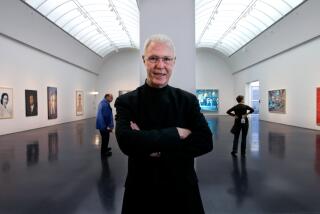School’s Faculty Producing a Work of Arts
- Share via
Most of the classrooms, studios and performance areas at CalArts occupy the same rambling building. Hallways connect the schools of art and theater and animation with few distinguishing signs or doorways to mark the way.
This sometimes-confusing design is significant. Founded in 1970, the Valencia institute was created to blur the distinctions between the arts. From the very beginning, students were challenged to invent new creative forms by combining old ones such as music, painting, film and dance.
An alternately chaotic and joyous experiment, CalArts has produced an array of successful alumni on its way to becoming one of the most respected art schools in the nation. But until recently, one constituency has been largely absent from the collaborative process--the faculty.
“The students connect at all kinds of levels, but the faculty--we’re all so busy,” said Tom Lawson, dean of the School of Art. “We work really hard at teaching and then we want to do our own work. So to find the mental space and the creative space to collaborate is difficult.”
Now Lawson and a group of his compatriots have made the effort.
They have established a production company, called @Muse.CalArts, and will stage William Butler Yeats’ “Deirdre” this weekend. Involving the schools of art, dance, music and theater, their company represents the most extensive collaboration of faculty in the institute’s history, officials say.
“If you have artists of this kind of accomplishment, it only makes sense to me to see what kind of work they can create together,” said Susan Solt, School of Theatre dean and the play’s producer. “I think this is extremely important.”
The project began with Solt’s associate dean, Irene Connors, who has worked with faculty from the dance and music schools on previous productions. For “Deirdre,” she hoped to widen her circle of allies.
Solt supported the idea, as did Michael Jon Fink, of the music school, and David Kroth, of the dance school, both of whom had worked with Connors. Various alumni were also eager to participate. Approaching Lawson, however, was another matter.
“I didn’t even know Tom,” Connors said. “I thought, ‘Oh, he won’t be interested in this, but I’ll try.’ ”
As fate would have it, Lawson had been toying with the idea of adapting his painting to the theater. “It was a nice surprise to have someone come over here and propose a joint project,” he said. “The theater school and the art school haven’t had much to do with each other.”
In time, faculty from various other schools and programs signed on. From there, it was a matter of coordinating schedules and getting acquainted with each other.
At one meeting, between Lawson and Kroth, neither man knew what to expect. Lawson felt nervous about entering an unfamiliar medium, while Kroth wondered if the painter could translate his work to the theater’s larger scale.
Then Lawson presented his idea for a particularly dramatic scene. He had designed giant masks to symbolize a group of soldiers who take the stage near the play’s end.
“It was the perfect image,” Kroth said. “And it doesn’t matter what his background was, those heads were very theatrical, and we all embraced them immediately.”
Connors credits this and other successes to “a particular energy here. We speak the same language across the institute.”
With an inaugural production set to debut, there is already talk of future efforts that might coalesce on film or as multimedia pieces.
“Anyone could sort of find the project. It could come out of art or music or dance,” Lawson said. “If we do everything we’re talking about doing, all kinds of combinations are interesting and possible.”
Said Kroth: “That’s the whole raison d’etre at CalArts. That’s the kind of work we should be doing.”
More to Read
The biggest entertainment stories
Get our big stories about Hollywood, film, television, music, arts, culture and more right in your inbox as soon as they publish.
You may occasionally receive promotional content from the Los Angeles Times.











